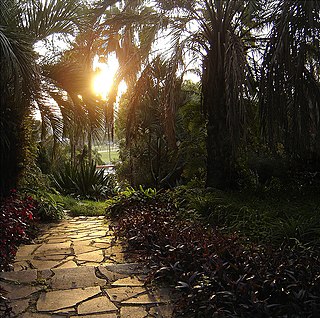
Porto Alegre is the capital and largest city of the Brazilian state of Rio Grande do Sul. Its population of 1,488,252 inhabitants (2020) makes it the 12th-most populous city in the country and the center of Brazil's fifth-largest metropolitan area, with 4,405,760 inhabitants (2010). The city is the southernmost capital city of a Brazilian state.

Caxias do Sul is a city in Rio Grande do Sul, Southern Brazil, situated in the state's mountainous Serra Gaúcha region. It was established by Italian immigrants on June 20, 1890. Today it is the second largest city in the state of Rio Grande do Sul. In 2020, the population of Caxias do Sul was estimated at 517,451 people, many of whom are of Italian and German descent. The demonym of the citizens of Caxias do Sul is Caxiense.

The Federal University of Rio Grande do Sul is a Brazilian public federal research university based in Porto Alegre, Rio Grande do Sul. UFRGS is among the largest and highest-rated universities in Brazil, having one of the largest number of scientific publications. From 2012 to 2019, the university was elected as the best federal university of Brazil. UFRGS has over 31,000 undergraduate students, over 12,000 graduate students, and more than 2,600 faculty members. As a Brazilian public federal institution, students do not pay tuition fees to enroll in courses offered by the university.

The Federal University of Santa Maria is a Brazilian public university located in Santa Maria, in the state of Rio Grande do Sul, funded by the federal government of Brazil. It was founded in 1960, by Professor José Mariano da Rocha Filho. Its campuses span over 1,837.72 ha, with a total of 386,968 m² of buildings and 28,307 students.

Unisinos is a Brazilian private Jesuit university founded in 1969. Its main campus is located in Southern Brazil, in the city of São Leopoldo, state of Rio Grande do Sul. Unisinos has more than 30,000 students in its 91 undergraduate programs, 19 academic master's programs, 6 professional master's programs, and 14 PhD programs, with six schools – Polytechnic, Business, Law, Health, Creative Industry, and Humanities.
The Prêmio José Reis de Divulgação Científica is an annual honor awarded by the Brazilian Council of Scientific and Technological Development (CNPq) to the institution, media organization, publication, or individual who most contributed to the dissemination and public awareness of science and technology in Brazil. It is thus named in honor of Dr. José Reis, a Brazilian biologist and science writer who was one of the pioneers in the field.

The Pontifical Catholic University of Rio Grande do Sul is a private non-profit Catholic university. With campuses in the Brazilian cities of Porto Alegre and Viamão, it is the largest private university of the state of Rio Grande do Sul and the first university founded by the Catholic religious institute of the Marist Brothers. PUCRS is considered the best private university of Brazil's Southern Region by the Ministry of Education (MEC), and one of the best private universities in the country, with FGV, PUC-Rio and the PUC-SP.

Carlos Roberto Velho Cirne Lima, also referred to as Carlos Cirne Lima, is a Brazilian contemporary dialectical philosopher. He obtained his doctor-degree in 1958 at the University of Innsbruck, Austria. Was a full professor at the universities UFRGS, PUCRS in Porto Alegre, and UNISINOS in São Leopoldo, Rio Grande do Sul.

The Porto Alegre Botanical Garden is a Foundation of Rio Grande do Sul located on the street Salvador França, in Porto Alegre, Brazil.
The Institute of Geosciences is a unit of instruction of the Federal University of Rio Grande do Sul (UFRGS). It includes the undergraduate courses of Geography, Geomatics Engineering, Geology. It has a department of study of vertebrate paleontology which has made great contributions to the geopark of Paleorrota.

Fórum Internacional de Software Livre (FISL) is an event sponsored by Associação SoftwareLivre.org, a Brazilian NGO that, among other goals, seeks the promotion and adoption of free software. It takes place every year in Porto Alegre, the capital of Rio Grande do Sul.
Atílio Munari was a Brazilian paleontologist.
Vicentino Prestes de Almeida was a Brazilian paleontologist.

The Museu de Ciências Naturais da Fundação Zoobotânica do Rio Grande do Sul, is a Brazilian museum located inside the Porto Alegre Botanical Garden. Open from Monday to Sunday 9am to 12pm and from 13h30 to 17h.
Macrocephalosaurus is a genus of rhynchosaurs from the Late Triassic period of southern Brazil. Although usually synonymized with Hyperodapedon, recent cladistic analysis has called this synonymy into question.

The Federal Institute of Rio Grande do Sul, or in full: Federal Institute of Education, Science and Technology of Rio Grande do Sul is an institution that offers high and professional educations by having a pluricurricular form. It is an multicampi institution, especialized in offering professional and technological education in different areas of knowledge.
Dudi Maia Rosa is a Brazilian artist.
The following is a timeline of the history of the city of Porto Alegre, in the state of Rio Grande do Sul, Brazil.

Arroio Dilúvio is a brook (arroio) in Porto Alegre, Rio Grande do Sul, Brazil, that flows in areas with high population density. It was or still is known by other names: Riacho Ipiranga, Arroio da Azenha, Riacho or Riachinho and even Arroio do Sabão, this being the current name of the stream that gives it its most distant source.














